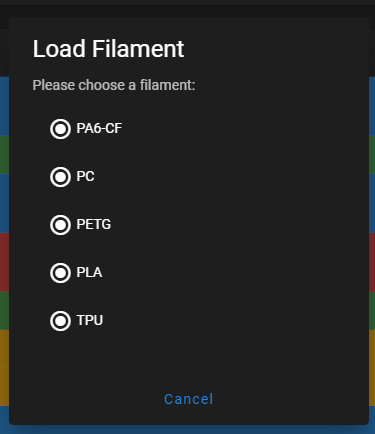Hey all,
I'm trying to figure out an issue I am having with filament changes. I'm not sure if this is a new issue, or if I just never noticed this before.
The way I have my duet configured is to use filaments stored on the machine.
I have a load.g, unload.g, and config.g for each filament.
Now, the problems arise when trying to load/unload filament from DWC.
First, if I select the filament from DWC and click 'unload', it heats the bed and waits for the bed to reach temperature first. Is this intended? This is even before it executes M702. This seems counterintuitive. Is this being influenced by tool change macros? When I run T0, it puts the bed into standby mode. However, my toolchange macros don't call for that to happen.
Also, when loading filament, it does not load the selected filament parameters before loading.
For example, if I have PLA loaded, with an active temp of 230, it will unload the PLA, keep the active temp of 230, then when it goes to load PETG it will keep the active temp of 230, even when running M703. I am assuming that this is because the PETG is not 'loaded' yet according to the system. Only AFTER all the macros are done, does running M703 update the temps.
Can anybody explain the logic here and help me figure out a way to get this to work, without needing to manually set temps in a load macro?
Here is load.g
M98 P"0:/macros/Filament/universal_load.g"
and here is the 'universal_load.g' macro
M703
M291 R{"Loading " ^ move.extruders[state.currentTool].filament} P"Please insert filament and press OK" S3
M302 P1 ;allow cold extrusion
G1 E10 F200 ; Feed 30mm of filament at 200mm/min
M302 P0 ;disallow cold extrusion
M568 A2
echo "set tool heater to active"
M98 P"0:/sys/pause_position.g"
var TargetTemp = tools[state.currentTool].active[0] ;set TargetTemp to current tool active temp
var thisHeater = tools[state.currentTool].heaters[0]
while (heat.heaters[tools[state.currentTool].heaters[0]].current < var.TargetTemp)
M291 R"Waiting for temperature to be reached." P{"Current: " ^ heat.heaters[var.thisHeater].current ^ " | Target: " ^ var.TargetTemp} S0 T2
G4 S2
M83 ; Extruder to relative mode
G1 E60 F200 ; Feed 60mm of filament at 200mm/min
G4 P10 ; Wait 10ms
while iterations >= 0
M291 P"Is color correct?" R"Color Change" S4 K{"Yes","No"}
if (input == 0)
break
if (input == 1)
G1 E40 F200 ; Feed 40mm of filament at 200mm/min
G4 P10 ; Wait 10ms
G1 E-1 F1800 ; Retract 1mm of filament at 1800mm/min
M400 ; Wait for moves to complete
M568 A0 ; Turn tool off
unload.g
M98 P"0:/macros/Filament/universal_unload.g"
and 'universal_unload.g' macro
;; Universal unload.g - direct all other filament unoad.g instances to this file
;;
;M929 P"0:/macros/filament/unloadeventlog.txt" S3
echo "entering 0:/macros/filament/universal_unload.g"
M703
if state.currentTool==-1
M291 R"No Tool" P"No tool selected. Press OK to unload tool 0" S2
T0 P0
if (move.extruders[state.currentTool].filament == "")
M291 R"Error" P"No filament loaded. Unload aborted" S2 T2
M99
M98 P"0:/sys/pause_position.g"
var TargetTemp = tools[state.currentTool].active[state.currentTool]
M568 A2; Heat current tool to active temp
G4 S3
var thisHeater = tools[state.currentTool].heaters[0]
;show progress of heating from lower temp
while (heat.heaters[tools[state.currentTool].heaters[0]].current < var.TargetTemp)
M291 R"Waiting for temperature to be reached." P{"Current: " ^ heat.heaters[var.thisHeater].current ^ " | Target: " ^ var.TargetTemp} S0 T2
G4 S1
M291 R{"Unloading " ^ move.extruders[state.currentTool].filament} P"Retracting..." S0 T5
M98 P"0:/macros/Filament/unload_moves.g"
M568 P{state.currentTool} A0 ; Turn current tool off
tpost0.g
; tpost0.g
; called after tool 0 has been selected
;
; generated by RepRapFirmware Configuration Tool v3.3.15 on Mon Dec 26 2022 22:40:57 GMT-0500 (Eastern Standard Time)
; Wait for set temperatures to be reached
M703
M116 P0
